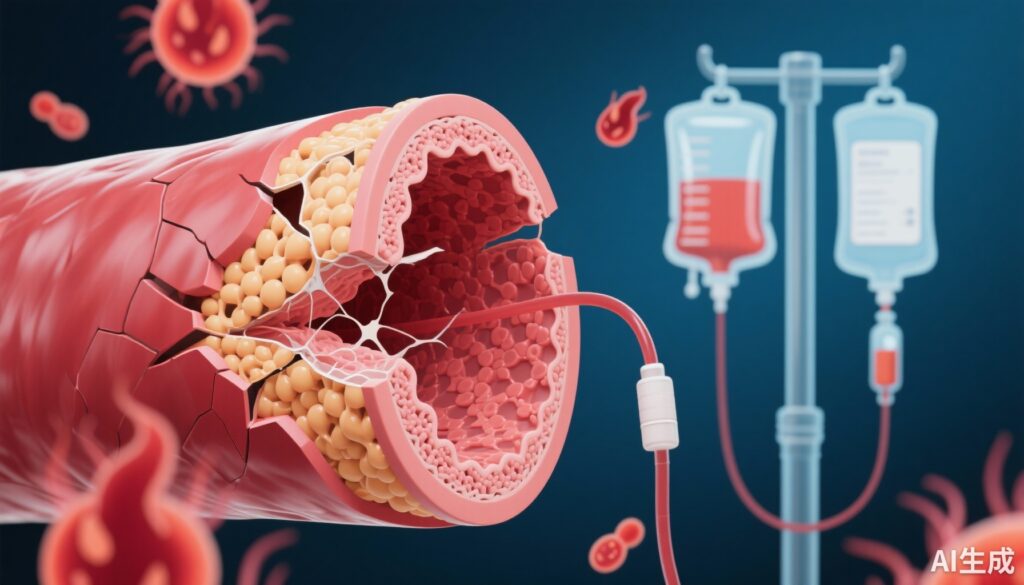Highlight
- Endothelial glycocalyx degradation, measured by plasma heparan sulfate and syndecan-1, strongly predicts 90-day mortality in sepsis.
- No significant difference in glycocalyx degradation was observed between liberal and restrictive intravenous fluid resuscitation strategies.
- Baseline glycocalyx degradation levels did not modify the effect of fluid resuscitation strategy on mortality outcomes.
Study Background and Disease Burden
Sepsis represents a major global health challenge characterized by life-threatening organ dysfunction due to a dysregulated host response to infection. Despite advances, mortality rates remain high. One important pathogenetic mechanism involves endothelial dysfunction and particularly degradation of the endothelial glycocalyx — a carbohydrate-rich layer lining the vascular endothelium that regulates vascular permeability, leukocyte adhesion, and coagulation. Prior experimental and observational studies suggest that disruption of the endothelial glycocalyx contributes to microvascular leakage, inflammation, and organ injury in sepsis.
Intravenous fluid resuscitation is a cornerstone of sepsis management aiming to restore hemodynamic stability. However, growing evidence raises concerns that liberal fluid administration may exacerbate endothelial injury and glycocalyx degradation, potentially worsening outcomes. Yet, clinical trials rigorously evaluating the relationship between fluid strategies and glycocalyx integrity remain limited.
The CLOVERS (Crystalloid Liberal or Vasopressors Early Resuscitation in Sepsis) trial provided a pragmatic platform to investigate these questions in a controlled, multicenter environment. This analysis focused on whether baseline endothelial glycocalyx degradation predicted mortality and how fluid resuscitation strategies influenced glycocalyx degradation and patient survival.
Study Design
This substudy of the CLOVERS trial employed an enriched sampling strategy to select a cohort of 574 adult patients with sepsis randomized to two fluid resuscitation approaches: a liberal fluid strategy versus a restrictive fluid strategy (early use of vasopressors with limited crystalloid infusion). The trial is a phase 3, multicenter, randomized controlled trial enrolling patients at risk of shock from sepsis.
The primary biomarker for endothelial glycocalyx degradation was plasma heparan sulfate, quantified by mass spectrometry, reflecting the shedding of glycosaminoglycans from the endothelial surface. Plasma syndecan-1, measured by enzyme-linked immunosorbent assay (ELISA), served as a clinically feasible complementary marker.
The primary clinical outcome was 90-day all-cause mortality. The study assessed:
1. The association between baseline glycocalyx degradation and mortality.
2. The effect of assigned fluid resuscitation strategy on glycocalyx degradation 24 hours after randomization.
3. Whether baseline glycocalyx integrity modified the impact of fluid strategy on mortality.
Key Findings
Baseline plasma heparan sulfate levels strongly correlated with mortality risk in a graded manner. Patients in the lowest heparan sulfate tertile had a 9.9% mortality (95% CI, 7.0-12.7%), the middle tertile 20.4% (15.6-25.0%), and the highest tertile 44.2% (35.6-51.6%), with a highly significant difference (P<0.001). Adjusted hazard ratio for mortality per interquartile range increase in heparan sulfate was 3.12 (95% CI, 2.18-4.46), underscoring a robust association.
Similarly, syndecan-1 levels corroborated this finding, underscoring the validity of these biomarkers in reflecting endothelial glycocalyx integrity.
Despite the theoretical concern that liberal fluid administration might exacerbate glycocalyx degradation, the trial found no statistically significant difference in plasma heparan sulfate or syndecan-1 levels between the liberal and restrictive fluid groups at 24 hours post-randomization. This suggests that the volume of intravenous crystalloid administered did not impact glycocalyx shedding in the acute resuscitation phase.
Furthermore, no interaction emerged between baseline glycocalyx degradation and treatment allocation regarding mortality at 90 days, indicating no differential benefit or harm from fluid strategies based on glycocalyx status.
Expert Commentary
This comprehensive analysis clarifies important clinical uncertainties regarding endothelial glycocalyx dynamics and fluid resuscitation in septic shock. The strong correlation between glycocalyx degradation and mortality is consistent with existing literature implicating endothelial injury in sepsis outcomes.
However, the lack of effect of fluid strategy on glycocalyx degradation contrasts with some mechanistic hypotheses and smaller observational studies asserting that fluid overload disrupts the glycocalyx. Possible explanations include that endothelial damage in sepsis is predominantly driven by the underlying inflammatory milieu rather than volume status per se, or that the 24-hour biomarker measurement window was insufficient to capture longer-term effects.
The study’s strengths include its randomized design, rigorous biomarker quantification methods, and clinically meaningful endpoints. Limitations comprise the enriched sampling cohort, which may affect generalizability, and the relatively short biomarker follow-up. Future studies might explore serial glycocalyx measurements and interventions specifically targeting glycocalyx preservation.
Clinically, these findings support current sepsis guidelines emphasizing individualized fluid resuscitation without undue concern for glycocalyx degradation from liberal crystalloid use. Yet, endothelial injury remains a critical therapeutic target in sepsis.
Conclusion
Endothelial glycocalyx degradation is a potent predictor of mortality in sepsis, underscoring the endothelium’s pivotal role in sepsis pathophysiology. The CLOVERS trial subanalysis reveals that liberal versus restrictive fluid resuscitation strategies do not differentially influence glycocalyx integrity or 90-day survival outcomes. Baseline glycocalyx degradation levels do not modify the effect of fluid resuscitation strategy on mortality.
These insights suggest that therapeutic approaches to preserve or restore the endothelial glycocalyx in sepsis should focus beyond fluid management strategies. Targeted pharmacologic therapies, anti-inflammatory agents, and adjunctive treatments remain areas for active research to improve vascular health and sepsis survival.
References
1. Oshima K, Di Gravio C, Yan B, et al. Endothelial Glycocalyx Degradation in Sepsis: Analysis of the Crystalloid Liberal or Vasopressors Early Resuscitation in Sepsis (CLOVERS) Trial, a Multicenter, Phase 3, Randomized Trial. Ann Am Thorac Soc. 2025 Sep;22(9):1382-1393. doi: 10.1513/AnnalsATS.202501-012OC. PMID: 40315385; PMCID: PMC12416157.
2. Schmidt EP, et al. The endothelial glycocalyx and acute lung injury. Curr Opin Crit Care. 2020;26(1):42-49.
3. Annane D, et al. Fluid resuscitation in septic shock: a narrative review on clinical practice and research. Crit Care. 2022;26(1):15.
4. Torres Filho IP, et al. Endothelial glycocalyx damage: A potential target in sepsis therapy. J Crit Care. 2023;71:154037.
5. Rhodes A, et al. Surviving Sepsis Campaign: International Guidelines for Management of Sepsis and Septic Shock 2021. Intensive Care Med. 2021;47(11):1181-1247.



